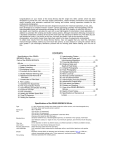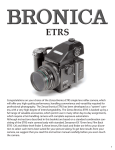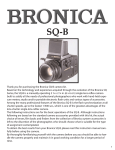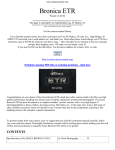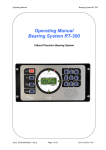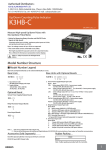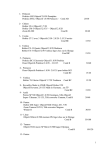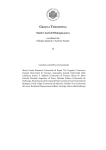Download Zenza Bronica GS-1 Instruction manual
Transcript
SQ-Ai Congratulations on your choice of the Zenza Bronica SQ-Ai single lens reflex camera; based on the technology and experience gained with the Zenza Bronica SQ-A. Developed for the professional photographer, the Zenza Bronica SQ-Ai also retains the full System of Photography of the earlier SQ-A, as well as having extensive interchangeability with the full range of accessories available for the SQ-A. Among the many professional features of the Zenza Bronica SQ-Ai is flash synchronization at all shutter speeds, up to the fastest 1/500 second, which is one of the chief features of the lens shutter single lens reflex camera. But, at the same time, the SQ-Ai also has full auto-flash control, based on TTL-direct light measurements at the film plane, with an exclusive SCA 386 System Adapter (optional), plus a compatible SCA 300 System electronic flash unit. Although instructions following are based on a standard combination consisting of the SQAi main camera body with standard Zenzanon-PS 80mm F2.8 lens, Film Back SQ-I 120 and Waist-Level Finder S, the actual choice of lens, film back and finder is left to the discretion of the photographer, who should choose what is suitable for the type of assignment contemplated. To obtain best results from your Zenza Bronica SQ-Ai, we suggest that you read this instruction manual carefully, before you even touch the camera. Thoroughly familiarize yourself with its working parts, before loading your first roll of film, and your pleasure in using the camera will be even greater. 1 Contents Specifications of the ZENZA BRONICA SQ-Ai Parts of the ZENZA BRONICA SQ-Ai 1. 2. 3. 4. 5. 6. 7. 8. 9. 10. 11. 12. 13. 14. 15. 16. 17. 18. 19. 20. 21. 22. 23. 24. 25. 26. 27. 28. 29. 30. 31. 32. 33. Loading the Battery Battery Checking Attachment and Removal of Film Backs Construction of Film Back Film Loading Film Speed Dial Exposure Compensation Dial Film Type Indicator Frame Film Advance and Shutter Cocking Exposure Counter Film Unloading Setting the Shutter Speed Dial Shutter Release Button Time (T) Exposure Exchanging Lenses Interchanging Finders Waist-Level Finder and Interchanging Magnifiers Setting the Aperture Focusing Adjustments Distance Scale and Depth of Field Scale Infrared Photography Flash Photography Multiple Exposures Mirror Lock-Up Interchanging Focusing Screens Removal and Attachment of the Film Winding Crank Assembly Attachment of the Neck Strap Facts About the Battery Pointers on Shooting Care of the SQ-Ai Depth of Field Table Interchanging Lenses Accessories for Increasing the Versatility Page 3, 4 5 6 6, 7 7, 8 8 9, 10 11 11 11 11 12 12 12, 13 13, 14 14 14, 15 15 15, 16 16, 17 17 17, 18 18 18, 19 19, 20 20, 21, 22 22 22, 23 23, 24 24 25 25, 26 27 28 29 2 Specifications of the ZENZA BRONICA SQ-Ai Type 6 x 6 cm format lens shutter single lens reflex camera, with interchangeable lens, film back, finder and focusing screen systems. Frame Size Film 55.6mm x 55.6mm 120/220/135 roll film and Polaroid Land pack film, with exclusive film backs. Lens Interchangeable type. Standard lens Zenzanon-PS 80mm F2.8; 6 elements in 5 groups; multi-layer anti-reflection coated; 50.7° angle of view; F22 minimum aperture; intermediate aperture settings; helical focusing from infinity to 80cm. 67mm diameter on Zenzanon-S/PS 40mm and Zenzanon-S 500mm lenses; 77mm diameter on Zenzanon-PS 50mm lens; and 122mm diameter on Zenzanon-PS 500mm lens. Filter Sizes Lens Mount Focusing Shutter Lens Diaphragm Film Winding Exclusive four-claw Bronica SQ bayonet mount. Helical focusing system built into each lens; angle of focusing 171° for standard lens. Electronic control SEIKO #0 between-lens leaf shutter; shutter speeds 16 sec. to 1/500 sec.; T (time exposure); B (bulb exposure); with shutter release lock. One step settings with Waist-Level Finder S and Prism Finder S. Fully automatic instant reopening lens diaphragm action; equal-distant aperture scale graduations; half-stops possible; depth of field previewing. Film winding crank; one complete forward revolution or ratcheted winding action. Multiple Exposure Multiple exposure possible with lever on camera main body; multiple exposure warning indication in finder. Mirror Lock-Up Mirror lock-up possible with switch lever on the camera main body; single or continuous mirror lock-up shooting possible. 3 Specifications of the ZENZA BRONICA SQ-Ai (con’t) Flash Synchronization Film Back Finder Focusing Screen Battery Checking Battery Dimensions Weight X-setting (up to 1/500 sec.); auto-flash control based on direct light measurements at the film plane with optional SCA System Adapter and SCA 300 System compatible electronic flash units. Daylight loading interchangeable type; exclusive film backs for 120, 220, and 135 roll films and Polaroid Land pack films; with film speed dial and exposure compensation dial; couples to finders with built-in exposure meter, when attached. Interchangeable finder system; 94% of actual field of view (remains unchanged when finder is exchanged.) Interchangeable type; standard microprism/split-image screen; optional screens are split-image, microprism, matte, grid-lines, microprism/split-image (for 135 film) and matte (for 135 film.) Red-colored LED lights up in front center area, outside screen area, when battery check button is depressed; LED also doubles as shutter closing signal. Four 1.5 volt alkaline-manganese batteries (LR44) 92mm wide x 109mm high x 179mm long (with standard lens, Film Back SQ-I 120 and Waist-Level Finder S.) 1,515 grams (with standard lens, Film Back SQ-I 120 and Waist-Level Finder S.) Specifications are subject to change without prior notice. 4 Parts of the ZENZA BRONICA SQ-Ai Flash synch socket Aperture ring Depth of field scale Distance scale Focusing ring Lens alignment dot Waist-level finder Focusing hood catch Magnifier release lever Shutter speed dial Shutter speed scale Magnifier Film speed contact Back cover release button (left) Shutter release button Back cover release button (right) Shutter release button locking ring Exposure counter Film winding crank Multiple exposure lever Finder release button Lens release button Battery check button Film plane mark Spool holder Depth of field preview lever Neck strap eyelet Manual film winder Shutter release button locking ring Cable release socket SCA adapter connector Mirror lock-up switch lever Dark slide slit Neck strap eyelet Film back release button Time exposure lever Exposure compensation dial lock button Exposure compensation dial scale (green-colored) Time exposure lever set screw Exposure ccompensation dial index (green-colored) Accessory mounting guide Flash synch contact Motor drive contacts Tripod socket (1/4” screw) Battery chamber cover release button Film type indicator frame Battery chamber cover Exposure compensation dial Film speed dial Film speed dial index (white-colored) 5 1. Loading the Battery The electronically controlled leaf shutter and the electro-magnetic shutter release system will not work without loading the batteries. Four 1.5-volt alkaline-manganese (LR44) batteries must be used. * The batteries may be obtained at any photographic equipment or electrical appliance dealer. A. Push the battery chamber cover release button on the base of the camera main body in the arrow-indicated direction and the battery chamber cover will spring open. B. A battery holder inside the battery chamber will spring up when the battery chamber cover is opened fully. Insert the four batteries into the battery holder, with polarities coincided to the plus (+) indications on the battery holder. Load all four batteries in the same direction. C. Upon loading the batteries into the battery holder, insert the battery holder into the battery chamber of the camera main body and close the battery chamber cover with your finger. * The battery holder can only be inserted one way because of its shape. 2. Battery Checking If a red-colored battery check LED lights up outside the focusing screen area (in the central front part of the finder), when the battery check button is pressed, the batteries are loaded properly and there is sufficient power for operations. * If the LED does not light up, (1) the batteries are not loaded properly or (2) the batteries are used and should be exchanged for fresh ones. 6 2. Battery Checking (con’t) * When the Motor Drive SQ-I is attached to the SQ-Ai main camera body, battery power for the main camera body is supplied from the Motor Drive SQ-I. In other words, the electrical circuit is switched so that the batteries of the motor drive operate the main camera body. Thus, it will not be possible to check the battery status (four LR44) loaded in the main camera body with the motor drive attached. In this case, the motor drive must be detached to check the batteries in the main camera body. * When using the AE prism Finder S, always check battery condition before attaching the finder, as the LED-illuminated shutter speed may be displayed, even when the battery check LED does not light up. Since correct AE operations will not be possible, in this case, exchange for fresh batteries. 3. Attachment and Removal of Film Backs The film back is a film chamber that can be attached or detached at any time, permitting rapid change of film types even during shooting sessions. The main camera body and film back are fully coupled, upon connection. Therefore, always turn the film-winding crank completely one time, upon attaching the film back. If winding is not possible, all preparations for taking the picture have been completed. But, if winding is possible, rotating the film winding crank until it stops will automatically take care of the incomplete action, whether it is an uncocked shutter or the film has not advanced. Thus, it is always possible to choose the film type most suited for the shot, even midway in the roll. A film speed dial is available on the film backs and can be used for setting the film speed of the film loaded in the film back, which will, furthermore, automatically couple when any finder with a built-in exposure meter is attached to the camera main body. This should be very convenient when using films of different sensitivities in various film backs. The film speed dial is calibrated for ISO/DIN film speeds. An exposure compensation dial is also available around the film speed dial. Additional film backs are available optionally in 6 x 6, 6 x 4.5 and 35mm formats. * See the instructions supplied with Film Back SQ 135 for proper use. A. To attach the film back to the main camera body, simply insert the latches at the upper end of the film back into the attachment openings at the upper end of the camera main body. Then, press the lower end of the film back against the main body until it locks securely. 7 3. Attachment and Removal of Film Backs (con’t) B. To remove the film back from the main camera body, insert the dark slide into the dark slide slit, as illustrated, with the mark on the dark slide at the top end. Push it all the way in. C. Depress the film back release button and the lower end of the film back can be removed, as illustrated. Simply shift the film back up slightly and pull it away. * The dark slide cannot be withdrawn from the film back when the film back is detached from the main camera body. * The dark slide must be withdrawn from its slit, upon attachment of the film back to the main body, otherwise the shutter cannot be released. Furthermore, there is danger of the film back accidentally becoming detached from the main body, should the dark slide be left in its slit while the camera is being carried. Therefore, make it a rule to withdraw the dark slide promptly upon attaching the film back to the main body. 4. Construction of Film Back A. The film back consists of a film holder and a film back frame, with exclusive film backs available for 120 and 220 roll films in 6 x 6 & 6 x 4.5 formats. The film holder has an insert on the frame for loading film, and has a built-in film winding mechanism. B. The film back frame has a base with a dark slide slit and a back cover with an ISO/DIN film speed dial, an exposure compensation dial and a film type indicator frame. The film back frame completely encloses the film insert and shields it from outside light, as well as connecting it to the camera main body and also coupling with any finder having a built-in exposure meter. 8 5. Film Loading A. To open the back cover, squeeze the left and right back cover release buttons, in the arrow-indicated directions, at the same time and the back cover will open. B. The film holder can be taken out for film loading upon opening the back cover. C. There are two spool holders on the film holder. The top one is for the fresh film spool while the bottom one is for the empty take-up spool. The left-side shaft of the spool holder can be opened by pushing the fresh film spool outward in the arrow-indicated "A" direction. Then, insert the right end of the spool on to the right-side shaft, which is fixed, and then close the left-side holder (shaft), which will engage the spool. * The spool holders on the left side will be locked securely when the back cover is closed. D. After loading the fresh film spool properly, draw out the leading end of the film and turn it across the film pressure plate (as illustrated). Run it down and turn it over to the take-up spool. Insert the leading end into the slit of the take-up spool and wind slightly until securely engaged. * The inside black surface of the leader must face out when running across the pressure plate. E. Rotate the film back winding crank on the right side of the film insert in the direction indicated by the arrow, while checking the advancing film. When the starting point, or arrow mark, is aligned with the triangular start-mark on the top left side of the film insert, stop rotation. 9 5. Film Loading (con’t) F. The starting point, or arrow mark, of the unexposed film, can also be aligned with the start-mark, with the film insert loaded in the film back. Simply rotate the film-winding crank on the main camera body. This method is preferred since there will be coupling with the main camera body mechanism, from the beginning. * If the film is not advanced when the film-winding crank is rotated, the film holder is not inserted properly and/or the main camera body may be set for multiple exposures. In the latter case, return the multiple exposure lever to an upright or vertical position. (See 23. Multiple Exposures.) G. Close the back cover, by pressing it firmly against the base of the film back, as illustrated. The back cover will automatically close and lock. The same operation will close the back cover when the film back is detached from the main body. H. Upon loading the film, rotate the film-winding crank until it stops to place the first frame into place for taking the picture. The exposure counter will also change from "S" to "1", while the shutter will also be cocked. I. The manual film winder is used for advancing the film, when the film back is detached from the main body for film loading. The manual film winder can continue to rotate, even when the film is set for the first exposure. It should be rotated 2 or 3 times more, in order to take up any slack in the loaded film. * When loading 220 roll film in the Film Back SQ-I 220, do not mistake the dotted line before the arrow mark for the starting mark. 10 6. Film Speed Dial To set film sensitivity of the film loaded in the film back, rotate the film speed dial with a slight lifting action, as illustrated, and set the film speed scale to the index. There are click-stops at 1/3rd increments, in this case. * The film speed dial is automatically coupled to any finder with a built-in exposure meter, when attached. 7. Exposure Compensation Dial Exposure compensation up to +2 and -2 stops is possible at 1/3rd increments. To set the required compensation, slide the exposure compensation dial lock button, in the arrow-indicated direction, then rotate the exposure compensation dial, as required. When compensation is not needed, simply set to "0", where it is locked. * There will be no effect on the exposure, no matter where the film speed dial and exposure compensation dial are set, when a nonmetered finder is used. 8. Film Type Indicator Frame Upon loading the film, tear off the end flap from the empty film package and insert it in the film type indicator frame. This will help you keep track of the film loaded in the film back, even when two or more film backs are used with different films. At the same time, set the film speed with the film speed dial, when using finders with a built-in exposure meter. 9. Film Advance and Shutter Cocking Rotating the film-winding crank completely one time in the forward direction will advance the film and, at the same time, cock the shutter, with the winding action stopping automatically. On the other hand, short, rapid strokes up to an accumulated full rotation, will also do the job. * Please make sure that "N" on the mirror lock-up switch lever is set opposite the index when taking pictures which do not require mirror lock-up. 11 10. Exposure Counter The exposure counter shows the number of frames exposed or, in other words, is an additive type. Starting from "S", the counter on Film Back SQ-I 120 shows numbers from 1 to 12, while Film Back SQ-I 220 shows numbers from 1 to 24. The letter "S", and numbers "12" and "24" are orange-colored while all other numbers are white. 11. Film Unloading A. After the 12th exposure of the 120 roll film (24th exposure of the 220 roll film), the film-winding crank will turn freely with further rotations. Therefore, continue rotating the film-winding crank until the remaining film and all the leader paper is wound up on the take-up spool. Open the back cover when winding action becomes very light. B. Remove the film holder and while preventing the loose film from unwinding, take out the take-up spool. Seal the exposed film and return it to its original box until development. * Load and unload film away from direct sunlight and/or strong illumination. 12. Setting the Shutter Speed Dial A. The numbers on the shutter speed scale show the shutter speed that is set. For example, "8S" is 8 sec., "2" is ½ sec., and "500" is 1/500 sec. The shutter stays open as long as the shutter button or cable release is pressed on "B" (bulb). However, since battery power is drained during "bulb", time exposures should be made when the exposure time is longer than one minute. * See 14. Time (T) Exposure. 12 12. Setting the Shutter Speed Dial (con’t) B. The numbers on the shutter speed scale are divided into red and white colors. Red-colored numbers are full number settings of 1 second and longer while white-colored numbers are from ½ to 1/500 second. * The shutter speed setting can be changed before or after the film is advanced. * When the ME Prism Finder S or MF Finder S is attached, the settings "16S" and "B" (bulb) cannot be used. (This is because the electrical circuit is switched automatically so that shutter speeds are controlled with the shutter speed dials of the finders. 13. Shutter Release Button A. Depress the electro-magnetic shutter release button with the ball of the finger. Use a smooth, gentle action. A red-colored LED will light up momentarily in the front central area of the finder and will indicate that the exposure has been completed, when the shutter is released. Light up of the LED should be checked, especially when using slower shutter speeds. In the following cases, the shutter will not be released and the shutter release warning LED will light up, except in the first instance: 1. Shutter release button is locked. 2. Dark slide is inserted. 3. Film is not advanced. (Same when exposure counter is between "S" and "1". 4. Shutter is not cocked. 5. Lens is not attached properly. (Same with automatic extension tubes) 6. Lens release button is depressed. 7. All frames (i.e. 12 frames for 120 roll film and 24 for 220 roll film) have been exposed. * The shutter blades will close and there will be an under-exposure if the film-winding crank is accidentally rotated before the exposure is completed, in the case of a slow shutter speed setting. In this case, the next frame may also be exposed and result in an improper exposure as well. 13 13. Shutter Release Button (con’t) * The shutter release button of the main camera body should be locked, when the camera is not being used. The shutter release button may be depressed accidentally while the main camera body is being carried in a bag, which could lead to discharge of the battery power. To lock the shutter release button, rotate the locking ring and coincide the orange dot to "L". 14. Time (T) Exposure Time exposures are made with the time exposure lever on the lens, regardless of the setting on the shutter speed scale. A. First, cock the shutter with the film-winding crank and then pull up the time exposure lever release. * Except for time exposures, always shift the time exposure lever so that the letter "A" is visible on the lens barrel and keep the time exposure lever release pushed in all the way. B. Slide the time exposure lever and release the shutter, when a redcolored "T" is exposed on the lens barrel. The shutter will stay open until the time exposure lever is moved in the opposite direction, exposing the letter "A", which will close the shutter. This should be done after the last time exposure is made and prior to cocking the shutter. 15. Exchanging Lenses The lens cannot be attached or detached unless the shutter is cocked. Therefore, first, rotate the film-winding crank and cock the lens shutter. A. To attach the lens to the main body, align the orange dot on the main camera body and the red dot on the lens, and then insert the lens fully into its mount. Rotate in the counter-clockwise direction until it stops, with an audible click, which will indicate that it is securely locked. 14 15. Exchanging Lenses (con’t) B. To detach the lens, the film-winding crank must also be rotated to cock the lens shutter first. Then, press the lens release button down and at the same time, rotate the lens in the clockwise direction until it makes a full stop, at which point it will be possible to detach the lens. 16. Interchanging Finders A. The waist-level finder can be interchanged with other optional finders, to match shooting conditions to photographic conditions. To attach the finder, align the front end of the finder with the front end of the finder frame on top of the camera main body, as shown. Then, gently lower the finder and, when well seated, slide forward until it locks. B. To detach, simply depress the finder release button, while at the same time, sliding the finder backwards where it can then be taken off by lifting. * When using the AE Prism Finder S, always check battery condition before attaching the finder, as the LED-illuminated shutter speed may be displayed, even when the battery check LED does not light up. Since correct AE operations will not be possible, in this case, exchange for fresh batteries. 17. Waist-Level Finder and Interchanging Magnifiers A. The focusing hood of the waist-level finder is opened by pushing up on the focusing hood catch at the rear end of the folded waistlevel finder. * There is no standard finder for the Bronica SQ-Ai, with the user having a choice of several finders. Instructions are based on the waistlevel finder because of its popularity. 15 17. Waist-Level Finder and Interchanging Magnifiers (con’t) B. The magnifier is flipped into viewing position, by simply sliding the release lever in the arrow-indicated direction. To store the magnifier, simply push it down until it catches. * The magnifier can be exchanged for one matching the eyesight of the user. C. To close the focusing hood, first, push down the magnifier (if it is in viewing position). Next, press in both side frames, as illustrated, and at the same time, press the front frame back toward the rear. The focusing hood will automatically be folded down. D.The standard magnifier supplied with the waist-level finder has a power of -1.5 diopters, which can be exchanged for others with powers of -4.5, -3.5, -2.5, -0.5, +0.5, and +1.5 diopters. These optional accessories should be purchased to suit the user's eyesight, if necessary. Simply rotate the magnifier frame in the counter-clockwise direction to unscrew. Attach in the reverse manner. 18. Setting the Aperture A. The aperture ring is rotated, in either direction, to set the required f/number opposite the white index dot. The aperture ring click stops at the numbered settings. Intermediate settings are also possible. * Intermediate settings can be used with PS series lenses when the finder with built-in exposure meter is used. B. All interchangeable lenses for the Zenza Bronica SQ-Ai have fully automatic lens diaphragms, which means that the focusing screen is always viewed at the full aperture, providing the brightest possible image. However, depressing the depth of field preview lever will stop the lens diaphragm down to the pre-selected lens opening and permit the photographer to check the depth of field effect on the focusing screen. 16 18. Setting the Aperture (con’t) * The aperture ring must not be adjusted while the depth of field preview is being depressed. * If exposure measurements are taken with the depth of field preview lever depressed, when using a finder with built-in exposure meter, the shutter speed setting indicated will cause over-exposure. This is because proper exposures are obtained with exposure measurements made at the full aperture. 19. Focusing Adjustments A. The lens is focused on the subject, by rotating the focusing ring in either direction, while checking the effect on the micro-prism / splitimage range finder spot in the center of the focusing screen (standard type). B. The central split-image spot splits the image into two, with the upper and lower halves separated horizontally when the lens is out of focus. When in focus, however, the two halves will coincide with the displacement disappearing. The micro-prism ring surrounding the central spot can also be used for checking the sharpness of the focused image, since the image will glitter when the lens is not focused. The surrounding full-area matte surface can also be used for checking overall image sharpness. 20. Distance Scale and Depth of Field Scale A. Distance scales on the Zenzanon PS lenses can be used for focusing at the required distance or finding the distance actually focused. Simply rotate the focusing ring and set the required distance opposite the orange-colored index, which will adjust the lens for the required distance. 17 20. Distance Scale and Depth of Field Scale (con’t) B. There is an apparent zone of sharpness, both in front and back of the focused subject, which is known as the depth of field. The depth of field scale shows the zone of apparent sharpness at any lens opening or distance and can be utilized for quickly and simply ascertaining the depth of field. The depth of field scale is next to the distance scales and is made up of identical pairs of apertures on both sides of the orange-colored distance index. These identical pairs of apertures indicate the distance that will be in focus at these lens openings. For example, if the 80mm lens is focused at a distance of 3m (10ft.) it can be seen from the depth of field scale that the zone will extend from 2 to 7 meters (6ft. to 23ft.), when a lens opening of F22 is used. * See the depth of field table for the Zenzanon-PS 80mm lens. 21. Infrared Photography In infrared photography, some adjustment must be made in the focus in order to retain sharpness on the film, because the invisible infrared rays are longer in wavelength than the visible rays used for focusing. For infrared photography:1. Use an R filter or equivalent with an infrared (black-and-white) film. 2. The red-colored line, next to the orange-colored distance index, is the infrared index. 3. After focusing in the normal manner, re-set the distance indicated by the orange-colored distance index to the infrared index, by shifting the distance ring. 4. Follow instructions enclosed with the infrared film and filter, and to be on the safe side, make several bracketing shots. In general, more exposure rather than less seems to be a safe guide. 22. Flash Photography A. Always use flash cords with a standard PC type plug. When detaching the flash cord, grip the plug firmly and pull it out straight, instead of using a twisting action. 18 22. Flash Photography (con’t) B. The lens shutter of Zenzanon-S and PS series lenses have a X-setting for flash synchronization, which means that electronic flash units will synchronize at all shutter speed settings, up to the fastest 1/500 second. This means, of course, that flash fill-in for daylight shots can also be made easily. C. TTL auto-flash operations are possible with compatible SCA 300 System electronic flashguns, based on TTL-direct exposure measurements made at the film plane, when used in combination with the Bronica-exclusive SCA 386 Adapter. In this case, flash-ready and flash auto-check are indicated in the finder with an illuminated green-colored LED. * See instructions supplied with exclusive Bronica SCA System Adapter. When Mounting Bracket is used. The accessory Mounting Bracket provides great handling stability and shooting ease when using SCA 300 System electronic flashguns and has a special mount for accepting the SCA 386 Adapter. When Mounting Bracket is used with Motor Drive SQ-I or Speed Grip S. When the Mounting Bracket is used in combination with the Motor Drive SQ-I or Speed Grip S and the SCA 300 system electronic flashgun, the SCA 386 Adapter should be mounted on the hot shoe of the Motor Drive SQ-I or Speed Grip S, as the case may be. 23. Multiple Exposures A. To make multiple exposures, rotate the film-winding crank (to advance the film and cock the shutter). Turn the multiple exposure lever in the clock-wise or arrow-indicated direction, which will expose a red mark. When set in this manner, the shutter can be released and cocked any number of times, without advancing the film. 19 23. Multiple Exposures (con’t) B. When set for multiple exposures, a black square with a round cutout will appear in the right-front area of the focusing screen, as shown. C. Upon completing the multiple-exposed picture, be sure to return the multiple exposure lever back to its vertical position and cover the red mark. Otherwise, there will be additional multiple exposures on the same frame. 24. Mirror Lock-Up A. The mirror lock-up switch lever has 3 settings: N, S, and C. With the lever rotated to set N (normal) to the index for shooting without locking up the mirror and to S (single frame) or C (continuous) for shooting with the mirror locked up. * When shooting with the mirror locked up, always set the AE Prism Finder S to the manual exposure mode. B. For shooting with the mirror locked up, first, cock the shutter. Then, rotate the mirror lock-up lever in the arrow-indicated direction and coincide S or C to the index. The lens shutter will close completely and the reflex mirror and film safety plate will swing up. C. The shutter will be released when the shutter release button or cable release is depressed. 20 24. Mirror Lock-Up (con’t) D. When S is set to the index, with the mirror lock-up switch lever, the lever will automatically return to N, with the next film advance and shutter cocking action. All, following shots will, of course, be normal. E. When C is set to the index, with the mirror lock-up switch lever, the lever will not return to N with the next film advance and shutter cocking action. Therefore, shooting with the mirror locked up will be possible any number of times. * When the film-winding crank is revolved, after exposing all 12 or 24 exposures, film winding only, in the normal manner, will not take place but the shutter will be released with the mirror locked up any number of times. Therefore, always return the mirror lock-up switch lever to N, after the last 12th or 24th exposure and wind the film in the normal manner. F. To return to normal shooting, after shooting with the mirror locked up in the continuous mode, rotate the mirror lock-up switch lever and set S or N to the index; then, cock the shutter. When shooting is suspended, with the camera lens cocked and mirror lock-up in the S or C mode, rotating the mirror lock-up switch lever to N, will result in one of the following actions: 1. Shutter will be released, or 2. Shutter will not be released; furthermore, it will not be possible to press the shutter release button. * In order to prevent the above, shooting should be continued, in the following manner: a. Cover the lens and take one blank exposure, as follows: First, return the mirror lock-up switch lever to N setting. Then, use the multiple exposure lever and expose the frame. Finally, after exposing the frame, reverse the multiple exposure lever. (See 23. Multiple Exposures.) 21 24. Mirror Lock-Up (con’t) b. Utilize film back interchangeability and expose the frame after removing the film back from the main body. Then, continue shooting, according to "a". (See 3. Attachment and Removal of Film Backs.) 25. Interchanging Focusing Screens A. The focusing screen can be exchanged, depending on the type of photographic work being undertaken. First, remove the finder attached to the main camera body. Next, move the screen removal levers on both sides in the arrow-indicated directions, as illustrated. Then, using a pincer or similar tool, lift up the screen with the protrusion at the rear end. B. To install the focusing screen, insert the protrusion at the rear end of the screen in a corresponding groove on the main camera body. Then, slide both screen removal levers forward to secure the focusing screen. * Seven types of focusing screens are available for the Zenza Bronica SQ-Ai. 26. Removal and Attachment of the Film Winding Crank Assembly The film-winding crank assembly must be removed for attaching the Motor Drive SQ-I or the Speed Grip S to the main camera body. A. Lift up the release lever on the base of the film-winding crank assembly. 22 26. Removal and Attachment of the Film Winding Crank Assembly (con’t) B. And, at the same time, slide the base outward and the film-winding crank assembly will become detached. C. To attach the film-winding crank assembly to the main camera body, align the 2 pins and 3 catches on the attachment base to the openings on the base of the film winding crank assembly. D. And the slide the film-winding crank assembly in the arrow-indicated direction. 27. Attachment of Neck Strap A. First, insert the U-shaped ring into the neck strap eyelet, as illustrated. B. Next, place the plastic ring cover over the U-shaped ring, as illustrated. 23 27. Attachment of Neck Strap (con’t) C. Next, thread the neck strap through the plastic ring cover (and the U-shaped ring) and pull it out, as illustrated. D. After adjusting the length of the neck strap, pass the leading end of the strap through the buckle, as illustrated, which will fix it securely. * There should be no slack in the strap between the buckle and the plastic ring cover, or in "A" section, which means that both straps must be of the same length at this point. 28. Facts About the Battery The battery supplies power for the various electronic control mechanisms incorporated in the Zenza Bronica SQ-Ai. When used incorrectly, there is the possibility of the wrong exposure being set to the camera and/or the camera not operating. Be sure to use and store the battery correctly for obtaining optimum performance from it at all times. Take the batteries out of the battery chamber when storing the camera. Leaving the batteries in the camera for a long time, without using it, can lead to leakage problems and result in bad contact. Discard batteries with leakage or corrosion and thoroughly clean out the battery chamber. Clean the contacts of the battery chamber and battery with a soft cloth. Do not use sandpaper or emery cloth. Do not throw batteries into a fire, or hit them strongly, as there is danger of explosion. An alkaline manganese battery is used with the Zenzanon Bronica SQ-Ai. It has good cold weather resistance. However, there is a tendency for performance to drop when the temperature falls below 0°C (32°F). Therefore, make it a rule to use new batteries and/or keep replacement batteries on hand for shooting outdoors in freezing weather. Keep the batteries (and camera) under cover, next to the body, and load just before beginning the session and/or preferably use the optional Remote Camera Battery SQ-I. The shutter release button of the main camera body should be locked when the camera is not being used. The shutter release button may be depressed accidentally while the main camera body is being carried in a bag, which could lead to discharge of battery power. 24 29. Pointers on Shooting The shutter cannot be cocked when film is not loaded in the film back. The use of the multiple exposure lever will, however, permit you to cock the shutter in such instances. This feature is very convenient for familiarizing yourself with the camera and for testing the shutter in flash photography. (See 23. Multiple Exposures.) Battery power is not consumed when time exposures are made. The voltage will drop when the camera is used for long shooting sessions in freezing weather. Insert new batteries or keep a spare on hand, for such occasions. Furthermore, keep such batteries in an inside pocket. The focusing screen is detachable for exchanging with other types. Do not place trimming masks or tapes on bottom surface of the screen, as this will lead to inaccurate focusing. A red LED will flash above the focusing screen area and signal closing of the shutter when taking the picture. Wait for this signal, especially at slow shutter speeds, before rotating the film-winding crank. It should be remembered when taking pictures that the final print may not be a square format, especially if printed to an ideal format size, and will be cropped on both sides or at the top and bottom. 30. Care of the SQ-Ai Restrict cleaning of the reflex mirror to blowing or brushing with the blower brush or a soft camel hairbrush. Do not touch the surface with your fingers or a cloth. Use lens cleaning tissue and liquid to clean the surface of the lens. Do not use silicon-coated cloth for this purpose, as it will prove detrimental to the lens coating. Clean the plastic focusing screen in the same manner. Do not touch the surface as you may leave fingerprints. 25 30. Care of the SQ-Ai Protect your camera from temperature changes, which can result in moisture condensation, frost, etc., inside the body, leading to rusting of metallic parts. Protect your camera from impact and vibrations, too. Upon attaching the film back, always pull out the dark slide from its slit. Always protect the lens with its cover, when carrying the camera. Clean the camera and lens very carefully after using it outdoors in wet weather or at the seashore. Wipe the camera carefully with a well-wrung damp cloth, using fresh water, if the exterior is affected by salty air. Then, wipe it dry with a soft, dry cloth. If necessary, send it out for a quick inspection at an authorized repair station. If the equipment is not being used for a long period of time, store everything in tin-lined containers, with plenty of desiccant, such as silica gel. Finally store the equipment in a cool, dry and well-ventilated (but not windy) place. Do not over tighten when using a longer-than standard tripod screw, as you may damage the body. Both the main camera body and lens must be in the "cocked" condition to attach or remove the lens. In other words, when "cocked" the cocking pin of the lens will be set between the red band and green dot, while the cocking pin of the main body mount will be set to the green-colored dot. When not set in the above manner, the cocking pin of the detached lens can be set by moving it manually, while the cocking pin of the main body mount will be set by revolving the film-winding crank. Film Speed ISO ISO ISO ISO ISO 25 50 100-1600 3200 6400 Exposure Compensation Range -2 :: -1 :: 0 -2 :: -1 :: 0 :: +1 -2 :: -1 :: 0 :: +1 :: +2 -1 :: 0 :: +1 :: +2 0 :: +1 :: +2 Although exposure compensation up to ±2 stops is possible at 1/3rd increments, there are limits on the movement of the exposure compensation dial, as indicated in the table. 26 31. Depth of Field Table F/numbers 2.8 4 5.6 8 11 16 22 F/numbers 2.8 4 5.6 8 11 16 22 Distance (meters) oo 10 5 3 2 1.5 1.2 1.0 0.9 0.8 oo 12.9 5.62 3.20 2.08 1.54 1.23 1.02 0.91 0.81 43.5 8.17 4.51 2.82 1.92 1.46 1.17 0.98 0.89 0.79 oo 14.5 5.90 3.29 2.12 1.56 1.24 1.02 0.92 0.81 31.4 7.63 4.34 2.76 1.89 1.44 1.16 0.98 0.88 0.79 oo 17.9 6.38 3.43 2.17 1.59 1.25 1.04 0.93 0.82 22.2 6.95 4.12 2.67 1.85 1.42 1.15 0.97 0.87 0.78 oo 26.8 7.20 3.65 2.26 1.63 1.28 1.05 0.94 0.83 15.7 6.17 3.84 2.55 1.80 1.39 1.13 0.95 0.86 0.77 oo 89.2 8.82 4.01 2.38 1.69 1.32 1.07 0.96 0.84 11.2 5.33 3.50 2.40 1.73 1.35 1.10 0.94 0.85 0.76 oo oo 13.0 4.66 2.59 1.79 1.37 1.11 0.98 0.86 7.92 4.47 3.12 2.22 1.64 1.29 1.07 0.91 0.83 0.75 oo oo 39.1 6.07 2.95 1.95 1.46 1.16 1.02 0.89 5.62 3.65 2.70 2.01 1.52 1.22 1.02 0.88 0.81 0.73 Distance (feet) oo 30 15 10 7 5 4 3.5 3 oo 37.7 16.7 10.7 7.32 5.15 4.09 3.57 3.05 143 24.9 13.6 9.39 6.71 4.86 3.91 3.43 2.95 oo 42.0 17.4 11.0 7.45 5.21 4.13 3.60 3.07 103 23.4 13.2 9.18 6.60 4.80 3.88 3.41 2.94 oo 50.3 18.7 11.5 7.66 5.31 4.19 3.64 3.09 72.9 21.4 12.6 8.88 6.45 4.73 3.83 3.37 2.91 oo 70.0 20.8 12.2 7.97 5.45 4.27 3.70 3.14 51.7 19.2 11.8 8.48 6.25 4.62 3.77 3.32 2.88 oo 158 24.8 13.4 8.46 5.66 4.39 3.79 3.20 36.6 16.7 10.8 7.99 5.98 4.48 3.68 3.26 2.83 oo oo 34.0 15.7 9.27 5.99 4.58 3.92 3.29 26.0 14.1 9.69 7.38 5.65 4.30 3.56 3.17 2.76 oo oo 72.8 20.6 10.7 6.54 4.88 4.13 3.42 18.5 11.6 8.46 6.66 5.23 4.07 3.40 3.05 2.68 27 32. Interchangeable Lenses Zenzanon-PS 40mm F4 50mm F3.5 65mm F4 80mm F2.8 Macro 110mm F4 135mm F4 8 - 11 8 - 10 7-9 5-6 4-6 4-6 87 76 62.3 50.7 40 32.8 F4 ~ 22 F3.5 ~ 22 F4 ~ 22 F2.8 ~ 22 F4 ~ 32 F4 ~ 32 Minimum focus (m) 0.4 0.5 0.6 0.8 0.66 1.0 Filter Size (mm) 95 77 67 67 67 67 67.5 - 650 61.7 - 590 69.6 - 665 52 - 490 79 - 685 79 - 755 23 28 35 45 60 76 Lens Construction Angle of View F/numbers Length (mm)Weight (g) Equivalent 35mm focal length (mm) * Equivalent leaf shutter for all lenses: SEIKO #0, 16 sec. to 1/500 sec. plus B (bulb) and T (time exposure) Zenzanon-PS 150mm F4 180mm F4.5 200mm F4.5 250mm F5.6 500mm F8 S500mm F8 Lens Construction 4-6 8-9 5-7 5-7 10 - 11 6-7 Angle of View 29.5 24.7 22.8 18.2 9.2 9 F4 ~ 32 F4.5 ~ 32 F4.5 ~ 32 F5.6 ~ 45 F8 ~ 64 F8 ~ 45 Minimum focus (m) 1.5 1.0 2.5 3 8 8.5 Filter Size (mm) 67 67 67 67 122 95 74 - 750 96 - 865 107 - 870 85 100 110 F/numbers Length (mm)Weight (g) Equivalent 35mm focal length (mm) 150.2-1010 307.5-3760 255 - 1890 135 270 270 *Tele-Converter PS 2X and PS 1.4X are available. 28 33. Accessories for Increasing the Versatility Motor Drive SQ-i Compact and lightweight motor drive makes it possible for very speedy handling action, comparable to the 35mm single lens reflex camera. Fast operations are very easy with built-in shutter button and hot shoe, switching from single frame shooting to continuous shooting is possible, as well as incorporating a hand strap for single-hand operations. And, the motor drive has a remote control socket for wired remote control operations with an optional Remote Control Cord SQ-I, as well as wireless remote control operations with suitable equipment, which are available in photographic shops. Speed Grip S Compact and lightweight accessory, which provides the Zenza Bronica SQ-Ai with shooting speed and handling ease comparable to the 35mm single reflex camera. Speedlever and built-in shutter release button permits right-hand holding, with thumb-stroked film winding and shutter release action, thus leaving left hand free for focusing the lens. Also, has hot shoe for using cordless electronic flash units. Finder Interchangeability Prism Finder S Compact and lightweight eye-level finder with total reflection prism that shows a laterally correct upright image. Ideal for following fast action, as a very bright image of high magnification, observed (0.75x with 80mm lens). Also has high eye point eyepiece for very easy viewing, even by eyeglass wearers. 29 Finder Interchangeability (con’t) ME Prism Finder S Provides TTL full aperture measurements, with full-area average readings, for manual exposure control. Intermediate shutter speed settings are possible for both diaphragm-priority and shutter-priority adjustments. MF Finder S Waist-level type finder with eyepiece adjustment ring and large rubber eyecup, for use in careful composition work. It also permits TTL full aperture exposure measurements for manual exposure control, in both diaphragm-priority and shutter-priority modes. Waist-Level Finder S The accessory folds flat for storage but shows a laterally reversed up-right image when erected. Also, remember to flip-up the magnifier for critical focusing in careful composition work. It opens and closes with a single action. AE Prism Finder S The SQ-Ai is converted into a diaphragm-priority automatic exposure camera, with metering through the lens. Shows a bright laterally correct upright image at eye level, while pressing the shutter release button half-way can also check shutter speed. Meter-coupled manual exposure control is also possible. Automatic Close-Up Photography Zenzanon-PS 40mm F4 50mm F3.5 65mm F4 80mm F2.8 110mm F4 135mm F4 150mm F4 180mm F4.5 200mm F4.5 250mm F5.6 0.10 - 0.25 0.19 - 0.34 0.28 - 0.43 0.11 - 0.26 0.24 - 0.38 0.36 - 0.50 0.16 - 0.42 0.31 - 0.58 0.47 - 0.75 0.20 - 0.41 0.40 - 0.63 0.60 - 0.85 0.22 - 0.38 0.44 - 0.61 0.66 - 0.85 0.27 - 0.55 0.54 - 0.85 0.79 - 1.13 0.29 - 0.42 0.57 - 0.72 0.85 - 1.04 0.36 - 0.51 0.71 - 0.90 1.07 - 1.31 0.36 - 0.50 0.71 - 0.86 0.28 - 0.43 0.55 - 0.70 0.22 - 0.35 0.43 - 0.57 0.17 - 0.42 0.33 - 0.58 0.13 - 0.33 0.27 - 0.46 0.12 - 0.25 0.24 - 0.37 0.10 - 0.35 0.20 - 0.49 0.09 - 0.19 0.18 - 0.28 0.07 - 0.17 0.15 - 0.25 1.05 - 3.18 0.82 - 2.50 0.64 - 1.98 0.49 - 1.67 0.40 - 1.33 0.35 - 1.15 0.30 - 1.24 0.27 - 0.88 0.22 - 0.73 Close-Up Lenses S No. 1 No. 2 No.1+No. 2 Automatic Extension Tube S S-18 S-36 Automatic Bellows Attachment S 0.43 - 0.60 0.87 - 1.03 30 Film Back Interchangeability One of the chief features of the SQ-Ai is complete film back interchangeability. Thus, extra film backs will let a single SQ-Ai do the work of several cameras. For example: 1. Take color and black-and-white shots of the same subject. 2. Reload without losing a shot, even when shooting fast action, by using pre-loaded film backs. 3. Choice of films widened with the use of 35mm films. Unique frame sizes, such as 6 x 4.5cm and 24 x 54mm (with 35mm format film) are also available. 4. Instant pictures for previewing lighting and/or exposure are possible with Polaroid Land pack films. There are 7 types of film backs: Film Back SQ-I 120 - (12 exposures - 120 roll film) Film Back SQ-I 220 - (24 exposures - 220 roll film) Film Back SQ-I 120J - (15 exposures 6 x 4.5cm size - 120 roll film) Film Back SQ-I 220J - (30 exposures 6 x 4.5cm size - 220 roll film) Film Back SQ-I 135N - (Frame size 24 x 36mm) Film Back SQ-I 135W - (Frame size 24 x 54mm) Polaroid Film Back S - (8 exposures 8.3 x 10.8 cm size) 31 Flash Accessories SCA 386 Adapter TTL auto-flash photography based on direct film plane metering is simple with the SCA 386 Adapter and a SCA 300 System electronic flashgun. Also, provides ready-flash signal and auto-checking confirmation in the camera's finder area. Mounting Bracket Specially developed accessory made for flash operations with the SCA 300 System electronic flashgun. Has special mount for mounting the SCA 386 Adapter and, therefore, improves handling stability and makes integrated flash operations very easy. 32

































